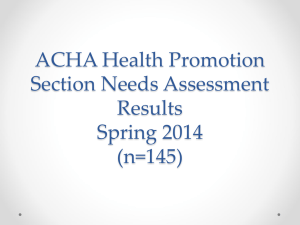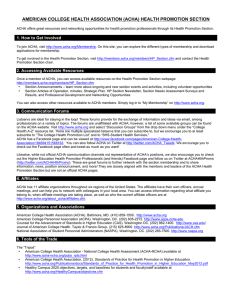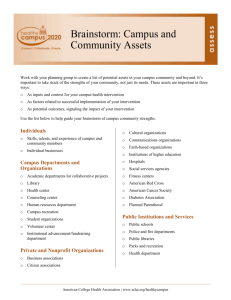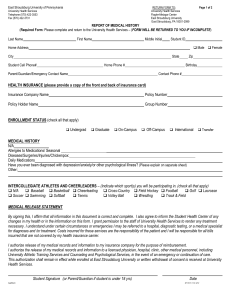presentation ( format)
advertisement
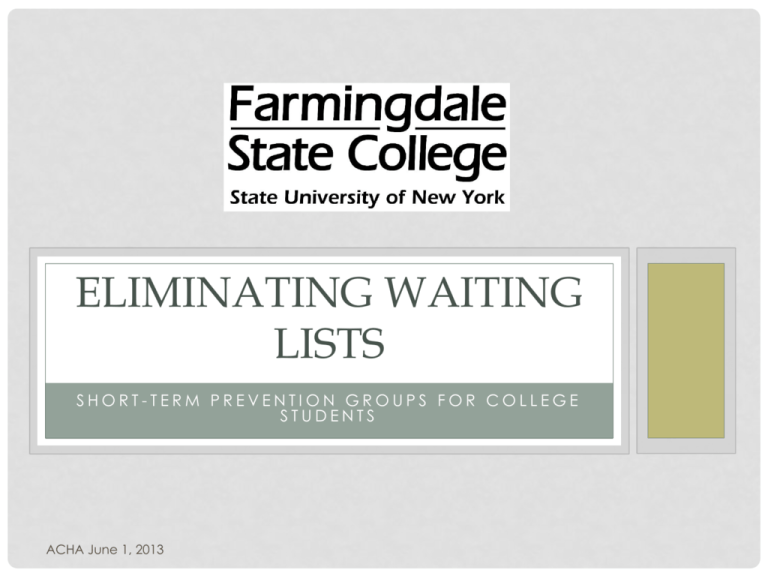
ELIMINATING WAITING LISTS SHORT-TERM PREVENTION GROUPS FOR COLLEGE STUDENTS ACHA June 1, 2013 PROGRAM AUTHORS – CAMPUS MENTAL HEALTH SERVICES • • • • • Shane Owens, Ph.D., ABPP, Assistant Director Andrew Berger, Ph.D., ABPP, Director Jill Bandura, Ph.D., Staff Psychologist Christopher Browne, Ph.D., Staff Psychologist 2012-2013 Psychology Externs: • Meredith McWillams, MS • Kristin Lopez, MS • Jameela Youssef, MS ACHA June 1, 2013 INTRODUCTION ACHA June 1, 2013 CAMPUS MENTAL HEALTH SERVICES • Four Full Time Staff • Three Licensed • One License-Eligible • Two Board Certified in Cognitive Behavioral Psychology by ABPP • Three Part-Time Psychology Externs • Master’s Level • In pursuit of Doctoral Degree ACHA June 1, 2013 CAMPUS MENTAL HEALTH SERVICES • All staff are on call 24 hours per day, 365 days per year • Services • Individual, couples, and group psychotherapy • Consultation and liaison services • Education and outreach • Works on an outpatient treatment facility model • Multisymptomatic outpatient population ACHA June 1, 2013 STATEMENT OF THE PROBLEM • 29% of college counseling centers place limits on sessions • 48% promote themselves as short-term services • Average number of sessions is 6.2 • 88% of directors report an increase in the number of students on campus with severe psychological problems • 92% of directors report an increase in the number of students seeking services ACHA June 1, 2013 Source: National Survey of College Counseling, Gallagher, 2012 STATEMENT OF THE PROBLEM (CTD.) • More than half of schools that responded place limits on number of sessions (as low as 5 sessions) • Survey respondents are seeing an average of 223 new cases per semester • Survey respondents indicated truncated hours based on budget and placing services when most needed ACHA June 1, 2013 Source: Unpublished SUNY CCD survey results, Owens & Berger, 2012 STATEMENT OF THE PROBLEM (CTD.) • At Farmingdale, we do not, nor have we in the last 30 years, had a waiting list • New patients are offered an appointment within 48 hours of calling or visiting the office • ALL crisis cases are seen immediately (some afterhours cases are dealt with by phone with the assistance of University Police and Residence Life staff) • University police attend the State Police Academy • Not campus security • Well-trained (most are EMTs) ACHA June 1, 2013 Source: Internal Data from FSC CMHS File Review STATEMENT OF THE PROBLEM (CTD.) • • • • No session limits Average number of sessions at CMHS: 5.95 Modal number of sessions at CMHS: 1 Median number of sessions at CMHS: 2 (heavy positive skew) ACHA June 1, 2013 Source: Internal Data from FSC CMHS File Review PROGRAM DESCRIPTION ACHA June 1, 2013 PROGRAM OVERVIEW • 4 Sessions • Delivered in groups of 4 to 8 students • Content: • Psychoeducation • Training in specific cognitive-behavioral technique for stress management • Highlighting other ways to manage stress ACHA June 1, 2013 SESSION 1: ICEBREAKER AND INTRO TO GROUP WORK • • • • Set goals Set rules for the group Ice breaker Initial measurement of symptoms ACHA June 1, 2013 SESSION 2: INTRODUCTION OF STRESS MANAGEMENT TECHNIQUES • • • • • • • Stress reaction Symptoms of stress Long-term effects of stress Sources of stress Some coping mechanisms Discussion of rational and irrational thought patterns Assign REBT homework ACHA June 1, 2013 REBT PRIMER “PEOPLE ARE NOT DISTURBED BY THINGS, BUT BY THE VIEW THEY TAKE OF THEM” – EPICTETUS – GREEK STOIC PHILOSOPHER REBT • A form of CBT created and developed by Albert Ellis (1913-2007) • Both a system of psychotherapy and a philosophy • Largely based on the writings of Greek Stoic philosophers REBT • Fundamental premise: we cause/increase emotional disturbance by the way in which we view events • Through the language we use, our beliefs, attitudes, and the meaning we give to events, others, and ourselves, we create/increase emotional disturbance. • Typically, people blame their emotional disturbance on events or on people ‘doing things’ to them (‘he/she makes me so angry!’) – REBT sees our beliefs, and specifically, the meaning we give those events, as the cause of those disturbances. A-B-C MODEL OF EMOTIONAL DISTURBANCE • A: Activating event – can be external or internal • B: Beliefs – include meanings, assumptions, attributions, desires, demands, etc. • C: (emotional/behavioral) Consequence • To the extent that one’s beliefs are rigid, absolute, and dogmatic, REBT predicts that individual will experience emotional and behavioral consequences that are frequently negative and self-defeating. ELLIS: THREE CORE IRRATIONAL BELIEFS – THE ‘3 MUSTS’ • I must do well and win the approval of others or I’m no good • Other people must treat me fairly and well 100% of the time, in exactly the way I want them to treat me, and if they don’t I’m no good and they deserve to be condemned • I must get exactly what I want, when I want it, and I must never get what I don’t want. It’s terrible if I don’t’ get what I want, and I can’t stand it SECONDARY IB’S • Demands: musts/shoulds/oughts • Awfulizing/Catastrophizing: it’s awful, terrible, horrible • Low Frustration Tolerance: I can’t stand it! • Self/Other/Life Ratings: I’m bad/worthless; life is not worthwhile; he/she is bad/worthless EXAMPLE INTERVENTION: IDENTIFYING IB’S, DISPUTING THEM, AND SUBSTITUTING RB’S • A) Final exams, Final projects • B) ‘it’s unfair! This professor expects too much from us’ - unrealistic demand ‘I can’t stand it! There’s no way I can do this’ - low frustration tolerance ‘I’m going to fail out of school!’ - catastrophizing C) Emotional: Anxiety, anger, frustration; Selfdefeating Behavior (procrastination, avoidance) SESSION 3: REINFORCING THOUGHTCHANGING TECHNIQUES • Review REBT homework • Extend awareness of IBs and RBs to working toward change • Assign homework ACHA June 1, 2013 SESSION 4: EXTENDING TECHNIQUES TO THE REST OF YOUR LIFE • Review homework • Discuss any difficulty that participants had with homework • Elicit future problems and strategies for dealing with them utilizing REBT principles • Elicit feedback • Encourage future help-seeking • Administer post measures ACHA June 1, 2013 RESULTS AND DISCUSSION ACHA June 1, 2013 MEASURES USED • • • • Beck Depression Inventory-Second Edition (BDI-2) Beck Anxiety Inventory (BAI) Beck Hopelessness Scale (BHS) Patient Health Questionnaire-9 (PHQ-9) ACHA June 1, 2013 PRE TO POST CHANGES 16 14 12 10 BDI BAI 8 BHS PHQ 6 4 2 0 Time 1 ACHA June 1, 2013 Time 2 PRE TO POST CHANGES Measure PRE (N = 4) POST (N = 4) T (df = 3) D M SD M SD BDI2 14.75 3.10 6.75 1.89 3.36* 3.10** BAI 12.50 8.10 6.25 3.30 2.20 1.01** BHS 5.25 3.40 2.25 1.89 1.23 0.36 PHQ-9 8.50 2.08 6.00 1.83 3.87* 1.28** ACHA June 1, 2013 DISCUSSION • This was in 2, imagine if we’d been able to do 4. • Program is easy to administer and repeatable. • Program can be extended in length and altered to fit specific diagnoses. • Program is efficient. • A more desirable alternative to waiting list or referral to outside providers. • May be used in conjunction with traditional approaches (e.g., individual therapy). • Not for those with serious psychopathology. ACHA June 1, 2013 QUESTIONS ACHA June 1, 2013
![Advanced Practice Clinicians Section 2014 []](http://s2.studylib.net/store/data/005266347_1-e47bbdee2346242f6ff85363ec775d6a-300x300.png)
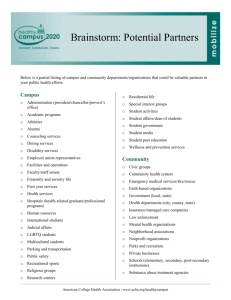
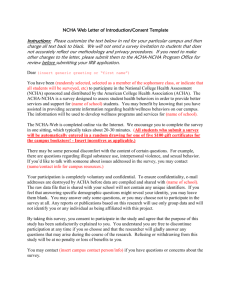
![October 2, 2015 Teleconference Meeting Notes [doc]](http://s3.studylib.net/store/data/006758571_1-fe3e8d561c05f53f7f19ee925597ef8d-300x300.png)
